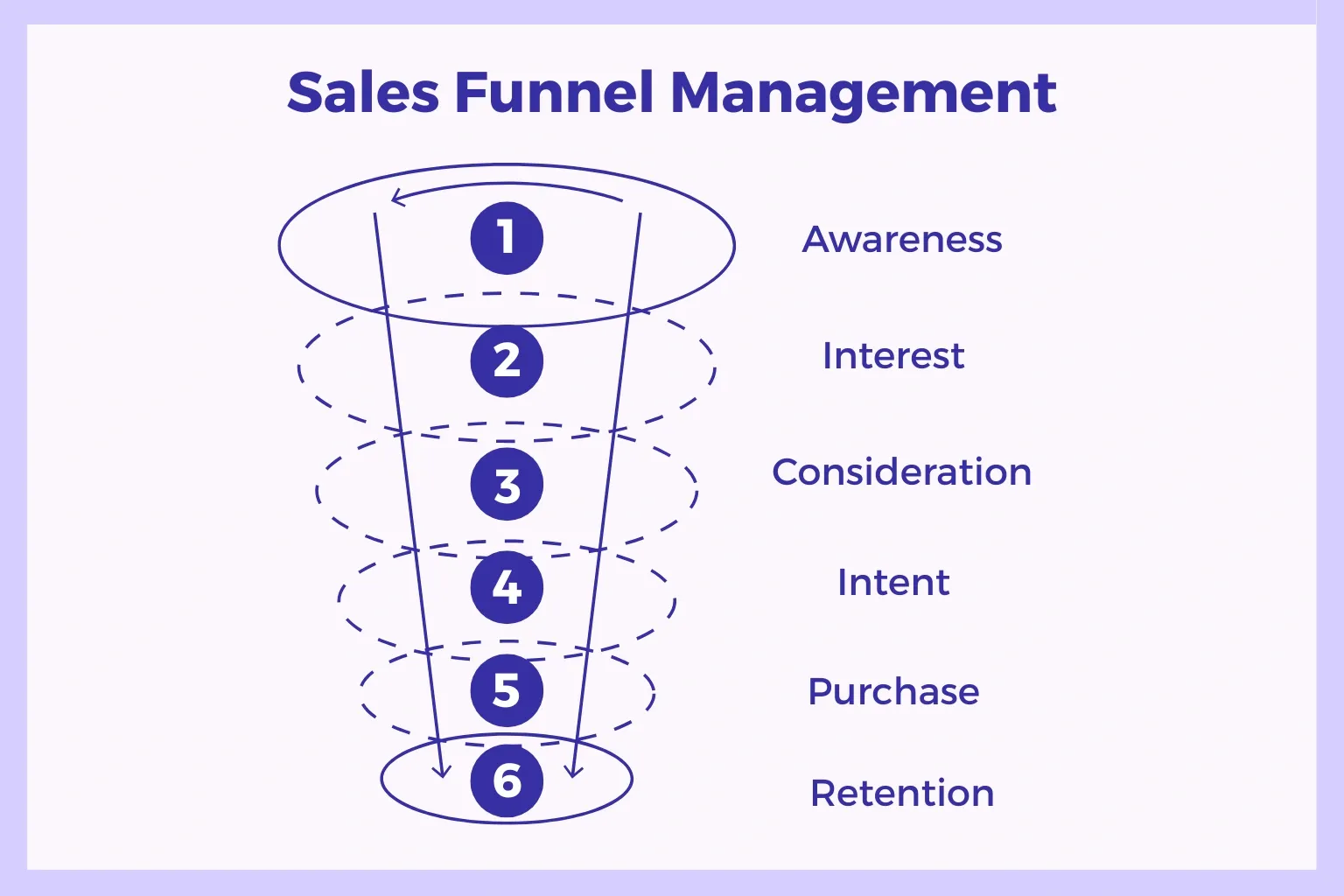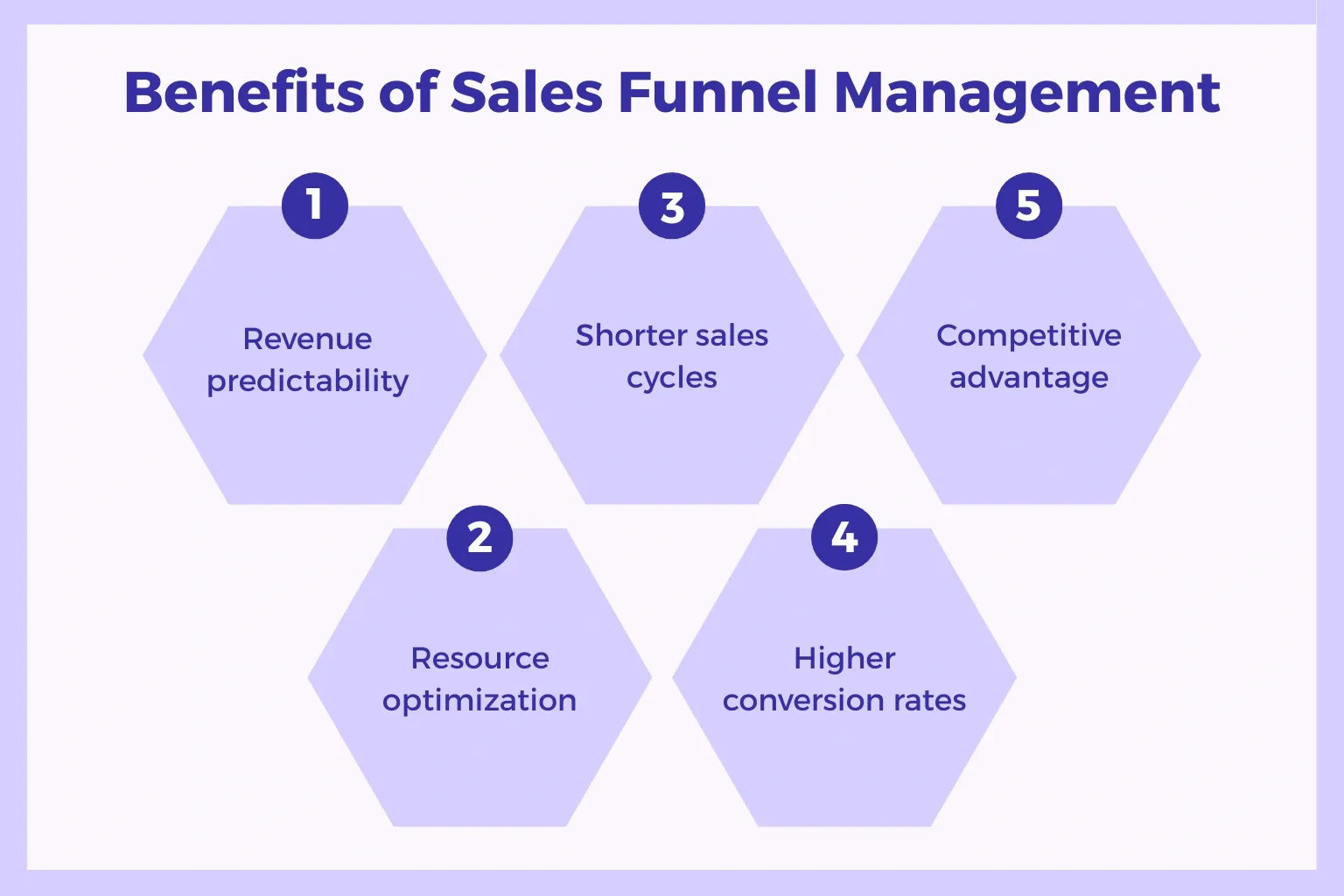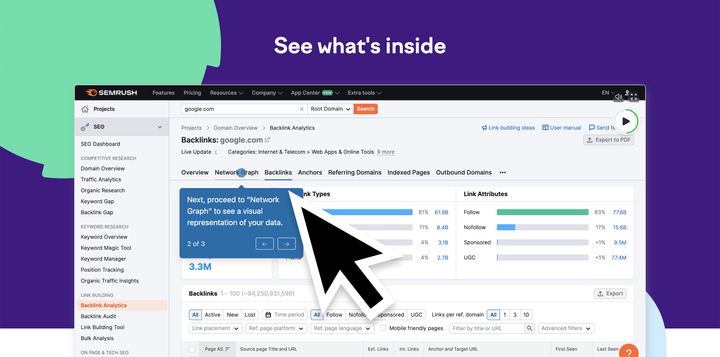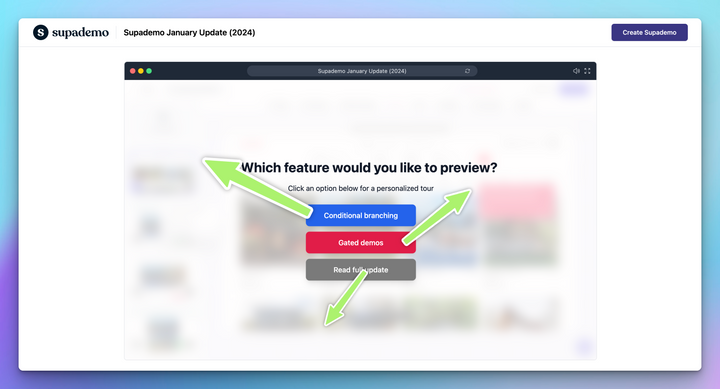Companies struggle with lead leakage between funnel stages, losing potential revenue that could have been captured with better sales funnel management.
Data shows that 79% of leads that you get from marketing never actually end up converting. So, it’s important to implement proper sales funnel management to ensure faster deal velocity and a higher close rate.
In this guide, we share everything you need to know about sales funnel management, from knowing every stage to implementing effective strategies that keep your pipeline flowing and your revenue growing. Let’s get started!
- Sales funnel management is a systematic approach to guiding prospects from awareness to purchase through defined stages and processes.
- Each funnel stage requires specific strategies, content, and metrics to maximize conversion rates and reduce drop-off.
- Effective management involves balancing lead volume, quality scoring, and nurturing processes to maintain steady pipeline growth.
- Track key metrics like conversion rates, velocity, and customer acquisition cost to identify bottlenecks and optimization opportunities.
- Supademo helps teams create interactive product demos that increase engagement and accelerate prospects through funnel stages more effectively.
What is sales funnel management?
Sales funnel management is the systematic process of guiding potential customers through each stage of their buying journey, from initial awareness to final purchase and beyond. It involves tracking, optimizing, and automating the flow of prospects through defined stages to maximize conversions and revenue.
For instance, consider a B2B SaaS company that tracks prospects from content downloads through demo requests, trial signups, and eventually to paid subscriptions. Each transition point requires specific strategies to move prospects forward while preventing drop-offs.
Effective sales funnel management combines lead scoring, nurturing campaigns, sales activities, and performance analytics to create a predictable revenue engine. It answers critical questions like which prospects are most likely to buy, what content moves them forward, and where bottlenecks occur in your sales process.
Sales funnel management stages

Each stage of your sales funnel serves a specific purpose in moving prospects closer to a purchase decision.
1. Awareness Stage
Studies show that 96% of customers research on their own before connecting with a sales team. In the awareness stage, prospects recognize they have a problem and start researching solutions.
Your goal is to capture attention through valuable content, SEO, and thought leadership. For example, a marketing automation platform might target prospects searching for "email marketing best practices" with educational blog posts and downloadable guides.
2. Interest Stage
In the interest stages, prospects show active interest in your solution category and engage with your brand. They download resources, subscribe to newsletters, or follow your social media. According to recent data, 74% of marketers said that content marketing helped them in creating demand or driving leads.
Success metrics worth tracking in the interest stage include content engagement rates, email open rates, and website session duration.
3. Consideration Stage
Prospects evaluate specific solutions and compare vendors. They request demos, download comparison guides, or attend webinars.
It is worth noting that during this consideration stage, up to 60% of buyers are ready to contact the sales team. So, it’s essential for sales teams to provide compelling product demonstrations and address sales objections quickly.
4. Intent Stage
Prospects signal buying intent through actions like requesting pricing, starting free trials, or scheduling sales calls. Sales velocity increases dramatically here, with deals moving much faster once prospects reach this stage.
5. Purchase Stage
Prospects become customers through contract negotiations, final approvals, and onboarding processes. Focus shifts to removing friction, addressing last-minute concerns, and ensuring smooth implementation.
6. Retention Stage
Customers receive ongoing support, training, and expansion opportunities. Well-managed retention programs can increase customer service metrics like customer lifetime value, reducing churn rates, and improved csat significantly.
Why is sales funnel management important?

Sales funnel management directly impacts your ability to generate predictable revenue and scale your business effectively. Here’s why it’s important:
- Revenue predictability: Managed funnels provide clear visibility into future revenue through pipeline analysis and conversion forecasting.
- Resource optimization: Knowing where prospects drop off helps you allocate marketing and sales resources more effectively.
- Shorter sales cycles: Systematic funnel management identifies and removes friction points that slow down deals.
- Higher conversion rates: Each stage optimization compounds to improve overall funnel performance.
- Competitive advantage: Organizations with mature funnel management processes respond faster to market changes, scale more efficiently, and capture market share from competitors with reactive sales approaches.
Challenges in managing your sales funnel
However, even experienced sales teams can face common obstacles that prevent optimal funnel performance. Some of the common challenges in managing a sales funnel include:
- Lead quality inconsistency: Marketing qualified leads (MQLs) often don't align with sales qualified lead (SQL) criteria, creating friction between teams. Many leads passed to sales are unqualified, wasting valuable selling time and creating negative customer experiences.
- Stage definition ambiguity: Without clear criteria for stage advancement, prospects get stuck or advance prematurely. This leads to inaccurate forecasting and misaligned sales activities.
- Technology gaps: Disconnected systems prevent comprehensive tracking and create data silos. Sales teams spend significant time on administrative tasks instead of selling when systems don't integrate properly.
- Content gaps: Prospects need different content at each stage, but many organizations lack stage-specific resources.
- Follow-up inconsistency: Manual follow-up processes result in delayed responses and missed opportunities.
- Attribution challenges: Learning which marketing activities drive the best customers becomes difficult without proper tracking.
Buyers don't want another long presentation. They want to see your product in action. Supademo helps you create interactive demos that let prospects experience your solution at every stage, reducing their decision time.
15 Sales funnel management tips to keep leads flowing
Here are some effective strategies that will help you optimize each stage of your sales funnel for maximum revenue impact:
1. Implement lead scoring systems
Lead scoring separates prospects who are ready to buy from those who need more nurturing. Instead of treating all leads the same, you assign point values to specific behaviors and attributes that indicate purchase intent.
1. Start with historical data: Review your closed deals from the past year and identify common actions these customers took before purchasing, then assign higher point values to these behaviors.
2. Create scoring tiers: Set up three buckets like cold leads (0-25 points), warm leads (26-50 points), and hot leads (51+ points) with different follow-up strategies for each tier.
3. Refine monthly: Track which scored leads actually convert and adjust your point values based on what behaviors truly predict sales, not just what creates activity.
2. Create stage-specific content
Prospects need different information depending on where they are in the buying process. Content that works for awareness fails at decision time because the questions have changed completely.
1. Map existing content: List all your content assets and assign them to funnel stages, then identify which stages have gaps where prospects might get stuck or leave.
2. Build content bridges: Create specific pieces that answer the exact questions prospects ask when moving between stages, like comparison guides for consideration to intent transitions.
3. Track content performance: Use your CRM to tag which content pieces prospects consumed before advancing stages, then create more of what actually moves deals forward.
3. Use interactive demos
You can use interactive demos as part of your sales funnel management process. These are clickable, self-paced walkthroughs that let prospects explore your product without waiting for a live call.
Here's an example interactive demo of Wise created using Supademo:
After implementing Supademo, beehiiv saw thousands of new signups, $10k in additional contracts, and a 50% higher free-to-paid conversion rate.
1. Top-of-funnel stage: Add short demos to your homepage, feature, or pricing pages to highlight your product’s core value and capture attention.
2. Middle of the funnel: Embed demos in nurture emails, share them in follow-ups, or include them in educational content so prospects can explore key workflows before a call.
3. Bottom-of-funnel stage: Equip champions with sandbox-style demos they can share internally, helping stakeholders test features and make faster, more confident decisions.
4. Track engagement data: Monitor which demo sections prospects spend time on and where they drop off, then optimize your live demos to focus on these high-interest areas.
4. Set up automated nurturing sequences
Manual follow-up means some prospects get five emails while others get forgotten. Automated sequences deliver consistent touchpoints based on prospect behavior, not whether your rep remembered to follow up.
Jeb Blount, a popular sales expert and author, highlights:
“Well-crafted prospecting sequences improve the statistical probability that you engage your prospect at the right time, through a preferred channel, with the right message.”
(Source)
1. Map trigger actions: Identify specific behaviors that indicate stage progression like content downloads, page visits, or email clicks, then build sequences that activate when these actions occur.
2. Write contextual emails: Create messages that reference the specific action that triggered the sequence, making each email feel personally relevant rather than obviously automated.
3. Set clear exit criteria: Define exactly when prospects should leave a sequence, whether they book a demo, go cold for 30 days, or show buying intent that needs human attention.
5. Define clear stage advancement criteria
Vague stage definitions create forecasting chaos. When reps guess whether deals qualify for later stages, your pipeline fills with opportunities that will never close while real buyers get ignored.
1. Document required actions: Create a checklist for each stage showing exactly what must happen before advancement, including both prospect actions and rep activities that need completion.
2. Train the team: Run exercises where reps classify deals based on your criteria, discussing different situations until everyone applies rules consistently across the team.
3. Audit weekly: Review a sample of recently advanced deals to check if they truly met criteria, then coach reps who are advancing deals prematurely or holding back qualified opportunities.
6. Monitor lead source quality
High lead volume from a channel means nothing if those leads never buy. Tracking source-to-close conversion reveals which channels generate real revenue versus vanity metrics.
Josh Braun, a popular sales expert, adds:
“Most teams track activity. Because activity is easier to measure. And fun to celebrate. But revenue? That’s the scoreboard. And based of what I’m seeing most companies aren’t looking at it by source.”
(Source)
1. Tag every lead source: Ensure your CRM captures the original source for every lead including campaign details, then track this data through to closed deals and revenue.
2. Calculate cost per customer: Divide total channel spend by customers acquired from that source, not just by leads generated, to see true acquisition costs.
3. Shift budget quarterly: Move spending from low-converting sources to high-converting channels based on actual revenue data, even if it means fewer total leads.
7. Track velocity metrics by stage
Knowing average time in each stage reveals where deals stall. When you measure how long prospects typically take to move between stages, you can spot problems early and fix them before losing deals.
1. Measure stage duration: Calculate average days spent in each stage for closed-won deals, then flag any current opportunity that takes significantly longer than your typical timeframe.
2. Identify common stalls: Review deals stuck beyond normal timeframes to find patterns like missing stakeholders, budget approval delays, or unclear value propositions.
3. Create acceleration plays: Build specific strategies for each common stall point, like executive briefing templates for c-suite approvals or ROI calculators for budget justification.
8. Personalize outreach at scale
Generic messaging treats all prospects the same, regardless of their role, industry, or specific challenges. Personalization acknowledges that different roles care about different outcomes, even when evaluating the same solution.
1. Segment by job function: Group prospects by role and create email templates addressing each role's specific pain points, metrics they care about, and outcomes they're measured on.
2. Reference company specifics: Use your CRM data to insert details about their company size, industry challenges, or tech stack into outreach, making messages feel personally researched.
3. Test personalization depth: Run A/B tests comparing generic emails versus personalized versions to find the personalization level that lifts response rates without taking too much rep time.
9. Design compelling calls-to-action
Weak CTAs like "Learn More" don't tell prospects what happens next or why they should click. Strong CTAs communicate specific value and create urgency without being pushy.
1. Lead with outcomes: Write CTAs that highlight the specific result prospects get, not the action they take, focusing on their goals like reducing costs or accelerating timelines.
2. Add qualifying details: Include specifics like timeframes or numbers that build credibility, such as "Get ROI Analysis in 5 Minutes" instead of "Calculate ROI."
3. Test placement and design: Experiment with CTA button colors, sizes, and page positions to find what drives clicks, then replicate winning combinations across your funnel.
10. Implement retargeting campaigns
Most prospects won't convert on their first visit. Retargeting keeps your solution visible while they evaluate options, research internally, and build consensus with their team. In fact, data shows that with retargeting, you can get up to 150% more conversions.
1. Create audience segments: Set up tracking pixels that tag visitors based on pages viewed like features, pricing, or case studies, then create custom audiences for each behavior.
2. Match message to behavior: Show different ad creative based on what prospects viewed, like competitor comparisons for those who checked your alternatives page or testimonials for pricing page visitors.
3. Cap frequency carefully: Limit impressions to 3-5 per week to stay visible without annoying prospects, and exclude recent customers who don't need continued advertising.
11. Add strategic social proof
Prospects need validation that others like them succeeded with your solution. Generic testimonials fail because they're not specific enough to build real confidence.
1. Segment testimonials by persona: Collect and display customer stories organized by industry, company size, and use case so prospects can easily find proof from similar buyers.
2. Quantify specific results: Push customers for hard numbers like "reduced onboarding time by 40%" instead of vague praise, making success concrete and believable.
3. Place proof strategically: Add relevant case studies at decision points where prospects need validation, like near pricing information or on demo request forms.
12. Optimize for mobile experience
B2B buyers research on phones during commutes, between meetings, and after hours. Clunky mobile experiences frustrate prospects who then check out competitors with better mobile sites.
1. Test critical paths mobile-first: Complete your entire funnel on a phone including form submissions, demo requests, and content downloads to find friction points.
2. Simplify mobile forms: Reduce required fields to absolute minimums on mobile, using progressive profiling to gather additional information later rather than upfront.
3. Check load speeds: Use tools like Google PageSpeed Insights to identify slow-loading pages, then compress images and remove unnecessary scripts until mobile pages load in under three seconds.
13. Create authentic urgency
False urgency damages trust when prospects see through fake countdown timers and artificial scarcity. Real urgency based on actual constraints motivates action while maintaining credibility.
1. Tie urgency to real events: Use genuine deadlines like quarter-end budgets, limited implementation capacity, or upcoming feature price increases rather than manufactured scarcity.
2. Explain the why: Tell prospects specifically what changes after the deadline and why, building understanding rather than just pushing for quick decisions.
3. Honor deadlines consistently: Never extend your urgency deadlines when prospects miss them, building a reputation that your timeframes are real and should be taken seriously.
14. Enable self-service options
Modern buyers want to research independently before sales calls. Self-service resources let prospects qualify themselves while gathering information that helps your team have better conversations.
1. Build a resource center: Create a hub with interactive demos, pricing calculators, comparison guides, and implementation timelines that prospects can access without gating or form fills.
2. Make resources easy to find: Add prominent navigation links and search functionality so prospects can locate answers quickly without digging through your site.
3. Track resource usage: Monitor which self-service tools prospects use before converting to identify what information truly helps decisions, then create more of what works.
15. Test and optimize continuously
Your funnel performance slowly degrades as market conditions shift, competitors adapt, and buyer behaviors change. Regular testing identifies small improvements that compound into significant gains.
1. Prioritize high-impact tests: Focus on elements that affect large traffic volumes like main landing pages, email subject lines, and primary CTAs rather than low-traffic pages.
2. Run one variable tests: Change only one element per test like headline, image, or CTA so you know exactly what drove results, avoiding multi-variable tests that muddy findings.
3. Document and share results: Keep a testing log with what you tried, results achieved, and lessons learned so your team builds institutional knowledge and doesn't repeat failed experiments.
Use Supademo in your entire sales funnel to 10x growth
Traditional sales demos and static presentations create friction in your funnel, causing prospects to disengage when they need to see your product in action most.
Supademo changes how prospects experience your product throughout the sales funnel, replacing boring slide decks with interactive, clickable demos that prospects can explore at their own pace.
Here's how Supademo can help you create a more effective sales funnel:
- Interactive HTML demos: Create clickable experiences that let prospects explore your actual product interface without requiring live demonstrations or lengthy setup processes.
- Guided screenshot and video-based demos: Capture screenshots and video-based steps that showcase key workflows and features relevant to each funnel stage.
- Showcase collections: Group and share multiple demos in one link or embed, guiding prospects through awareness, consideration, and decision stages with appropriate depth.
- Analytics: Track engagement and drop-offs to see exactly which features prospects explore, how long they spend in each section, and where they drop off to optimize follow-up conversations.
- Personalization: Customize and convert at scale with conditional branching that shows different features based on prospect role, industry, or use case for maximum relevance.
Sales teams using Supademo’s interactive demos report 33% faster deal velocity and higher close rates because prospects arrive at sales calls already engaged and educated.
Ready to create interactive demos that engage prospects, accelerate decisions, and drive revenue growth? Try Supademo for free today.
FAQs
What's the difference between a sales funnel and a sales pipeline?
A sales funnel focuses on the customer journey and conversion rates between stages. A sales pipeline tracks specific deals and their progression through your sales process.
How often should I review my sales funnel performance?
Review funnel metrics weekly for short-term optimizations and monthly for strategic adjustments. Quarterly reviews should focus on stage definitions and process improvements.
How do I know if my sales funnel needs optimization?
Key warning signs include declining conversion rates, increasing customer acquisition costs, and longer sales cycles. Also, watch for inconsistent lead quality between marketing and sales teams.
What metrics should I track for each funnel stage?
Track conversion rates, average time in stage, lead quality scores, and content engagement rates. Also, monitor the cost per progression for comprehensive funnel performance analysis across all stages.
How does sales funnel management integrate with CRM systems?
Modern CRMs provide funnel visualization, automated stage progression, and lead scoring capabilities. They also offer reporting features that support systematic funnel management processes and data-driven decision-making.




